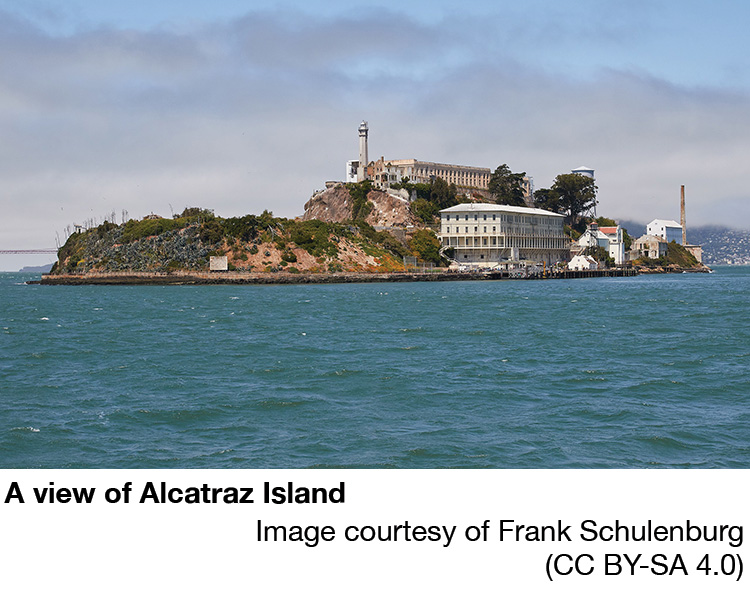Recent mention of the famous prison of Alcatraz provided this month’s article for ‘Letter from America’. I had the opportunity to visit the island in my early days in California when access was still possible. During the visit, I was guided to cells and facilities and told stories of attempted escapes.

Once considered the ‘prison of American prisons’, the island of Alcatraz in San Francisco Bay has been an asset to the US Army, the federal prison system, jailhouse folklore and the historical evolution of the West Coast. Despite its reputation as a cold and unforgiving penitentiary, Alcatraz is now one of the most prominent tourist magnets in San Francisco.
In 1775, Spanish explorer Juan Manuel de Ayala chartered what is now San Francisco Bay. He called the 22-acre rocky island ‘La Isla de los Alcatraces’, meaning ‘Island of the Pelicans’. With no vegetation or habitation, Alcatraz was little more than a desolate islet occupied by the occasional swarm of birds. Having never fired its own weapons in combat, Fort Alcatraz quickly evolved from an island of defence to an island of detention. In the early 1860s, civilians arrested for treason during the Civil War were housed on the island. Alcatraz as a jail would continue for 100 years. The average population of the island hovered between 200 and 300 people, never at maximum capacity.
After the devastating San Francisco earthquake of 1906, inmates from nearby prisons were transferred to the infallible Alcatraz. Over the next five years, prisoners built a new jail, designated ‘Pacific Branch, US Military Prison, Alcatraz Island’. Popularly known as ‘The Rock’, Alcatraz served as an army disciplinary barracks until 1933. Prisoners were educated and received military and vocational training here.
The Alcatraz of the early 20th century was a minimum-security prison. Prisoners spent their days working and learning. Some were even employed as babysitters for the families of prison officers. They eventually built a baseball field and inmates fashioned their own baseball uniforms. Boxing matches among inmates known as ‘Alcatraz Fights’ were hosted on Friday nights. Prison life played a role in the changing landscape of the island. The military transported soil to Alcatraz from nearby Angel Island and many prisoners were trained as gardeners. They planted roses, bluegrass, poppies and lilies. Under the order of the USA, Alcatraz was a fairly mild institution and its accommodations were favourable.
The Great Depression witnessed some of the most heinous criminal activity in modern American history and Alcatraz’s severity was well suited to its time. Alcatraz was home to notorious criminals, including Al ‘Scarface’ Capone, who was convicted of tax evasion and spent five years on the island. The most famous prisoner was Alaskan murderer Robert ‘Birdman’ Stroud, who spent 17 years on Alcatraz. Over its 29 years of operation, the federal prison housed more than 1500 convicts.
Daily life in the Alcatraz Federal Penitentiary was harsh. Prisoners were given four rights. They included medical attention, shelter, food and clothing. Recreational activities and family visits had to be earned through hard work. Punishments for bad behaviour included hard labour, wearing a 12-pound ball and chain and lockdowns, where prisoners were kept in solitary confinement and restricted to bread and water. There was a total of 14 escape attempts by over 30 prisoners. Most were caught, several were shot and a few were swallowed by the chilling swells of the San Francisco Bay.
The prison on Alcatraz Island was expensive to operate as all supplies had to be brought in by boat. The island had no source of fresh water and almost one million gallons were shipped in each week. Building a high-security prison elsewhere was more affordable for the federal government and as of 1963 ‘Uncle Sam’s Devil’s Island’ was no more. Alcatraz is currently run by the National Park Service, which, since 1973, has led guided tours of the now-closed historic site, and receives approximately 1.5 million tourists annually. Visitors take a round-trip ferry to walk the grounds and spend $60 million (approximately £45.2 million) a year to do it. The federal government closed Alcatraz in 1963, citing the high cost of operating it: it was three times as expensive as any other prison.
Current President Donald Trump said recently on his Truth Social website that he is directing the Bureau of Prisons, the Department of Justice, the Federal Bureau of Investigation (FBI) and Homeland Security to reopen the prison “to house America’s most ruthless and violent offenders.”
“I don’t know if he’s watching ‘The Rock’ or what inspired this,” California Governor Newsom told CBS Sacramento near the Peace Officers Memorial in downtown Sacramento. “I mean, you can’t even come up with a more colossally bad fiscal idea. Nothing about this makes any sense.” Newsom added that Donald Trump’s plan has “the form and substance of the stuff that flows in and out of the bay over Alcatraz every day.”
In response to a reporter outside the White House asking him why he wanted to reopen Alcatraz, President Trump said it was “just an idea I’ve had. It’s long been a symbol, Alcatraz, of whatever it is.”
He continued: “I mean, it’s a sad symbol, but it’s a symbol of law and order.” Part of Trump’s plan is to rebuild Alcatraz into a ‘substantially enlarged’ prison, which could house up to 336 prisoners.
Trump continued to show signs of cognitive decline on Monday at a press conference from the Oval Office, giving a bizarre word salad answer on why he wants the notorious federal prison Alcatraz reopened. Trump seemed to suggest it was his nostalgia for old movies that led him to push for reopening the prison, which has been closed for 61 years!
A US Bureau of Prisons spokesperson said they “will comply with all Presidential Orders” given.

Comments by members
This forum post has no comments, be the first to leave a comment.